The Rhoton Collection解剖合集可以说是神经外科专业医生的解剖圣经,每一位神经外科医生都应该下一番功夫来研究和学习。然而,笔者觉得只是观看视频往往无法深入的领悟其中的奥义,尤其是每一幅图片都非常的精美,最好是对照着解说认真仔细地去研究每一幅图片,才能事半功倍。于是笔者尝试用文字和动图的形式来呈现19部解剖视频,一来可以督促笔者系统的学习Rhoton的解剖,二来方便后期复习和查找。此项工作只是将Rhoton视频和字幕进行剪辑和制作,同时给重要的解剖名词标注英文,虽并非笔者原创,但也是一项耗时费力的工作。

Rhoton教授的视频解说只是点到为止,希望读者对不熟悉的解剖结构还需要自己去扩展学习。在此感谢唐寅达医生翻译的字幕,向每一位热爱神经解剖的前辈致敬。
本篇为《The Rhoton Collection 》Anterior Skull Base 前颅底第一部分。共184张图片。
前颅底(1)
Anterior Skull Base
▼今天我们一起学习前颅窝和中颅窝。我们神经外科医师都想要具备“透视眼”的本领,比如可以透过上方的结构想象出下方的解剖。
We're gonna look at the anatomy that of anterior and middle fossa. So we said we always want to have that see-through-X-ray vision so that when we're looking from above we could look downward and see all of this anatomy below.

▼又如从外侧就能看透内侧面的结构,再如显微镜下或内镜下操作时,从内侧完全看透外侧的解剖。
Also when we're working laterally, we want to have a view in a perception of what is medial, and when we're working medially, endoscopically or microsurgically, we want to have that X-ray vision that look from medial toward the lateral side.

▼来看一下颅底,这是前颅底(anterior skull base)、中颅底(middle skull base)
And as we look through the skull base, anterior skull base, middle skull base,

▼中央前颅底的下方是额窦(frontal sinus)
below median anterior skull base we see frontal sinus,

▼筛窦(ethmoid sinus)

▼蝶窦(sphenoid sinus)

▼眼眶位于外侧前颅底的下方
orbit below lateral anterior skull base.

▼筛前动脉、筛后动脉(anterior and posterior ethmoidal artery)

▼在中颅底下方,从外向内,可见颞窝(Temporal fossa)内有 颞肌(temporalis muscle)。
below the middle skull base laterally we see temporal fossa with temporalis muscle.

▼其内侧为颞下窝(infratemporal fossa),其向内开口于翼腭窝(pterygopalatine fossa [tərɪɡəʊ'pæleɪtaɪn])。
And then we come medially, we see infratemporal fossa that opens medially into pterygopalatine fossa.

▼翼腭窝(pterygopalatine fossa)

▼这是从侧方所见的结构,可见如下三角: 床突三角(clinoidal triangle)
And then looking at all of this from laterally, we see Clinoidal triangle,

▼动眼神经三角(Oculomotor triangle)

▼滑车上三角(Supratrochlear triangle)

▼滑车下三角(帕金森三角)(infratrochlear triangle; Parkinson's triangle)

▼中颅窝前内侧三角(anteromedial triangle)

▼前外侧三角(anterolateral triangle)
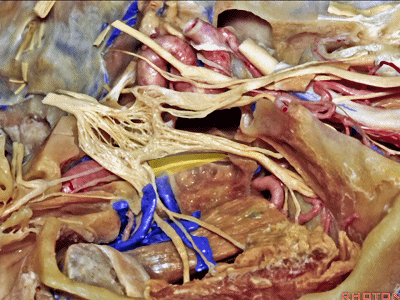
▼后外侧三角(Glasscock's 三角)(posterolateral triangle)

▼后内侧三角(Kawase's 三角)(posteromedial triangles)

▼岩浅大神经( Greater petrosal)

▼岩浅大神经,其移行为 翼管神经(vidian nerve),这是内镜下手术中非常重要的一个解剖标志。
Greater petrosal, and it is continuous with the vidian nerve. That's a very important landmark in endoscopic surgery.

▼岩浅小神经(lesser petrosal)
what nerve is this? This is lesser petrosal.

▼岩浅小神经支配的神经节是耳神经节(Otic)。其支配的腺体是腮腺(Parotid gland)。
What ganglion does it innervate? Otic. And what gland does it innervate then? Parotid gland.But we always wanna have that vision from below to above, and above to below.

▼这是常用的前颅窝入路。 这里我们抬起了骨膜瓣(pericranial flap)
Here's the common approach that we'll use to anterior fossa. We've elevated a pericranial flap,

▼颞肌(temporalis muscle)

▼对于该入路,我们通常经额窦做一个双侧额辦,然后做一个额-鼻骨切除术
Commonly in approaching this area, we'll turn a bifrontal flap through the frontal sinus and then do a frontal-nasal osteotomy

▼从而同时显露颅底上下方。
that will give us the area above and below the skull base.


▼因此该入路可局限化,也可扩大化,暴露范围可从一侧的眶外侧壁到另一侧
So these approaches can be limited or they can be very extended, extensive that go all the way from lateral orbital wall on one side to the opposite side,

▼显露的范围包括双侧眼眶(orbits)、前颅窝、
and gives you access to both orbits,anterior fossa,

▼鼻腔(nasal cavity)

▼正如我们所说的“透视”解剖功力
And you always want to have that X-ray vision from above to below.

▼在前方,可见额窦,其范围可很大。
And anteriorly we see frontal sinuses that can be very extensive.

▼后方是筛窦(ethmoid sinus)
Behind that,ethmoid sinuses, and then
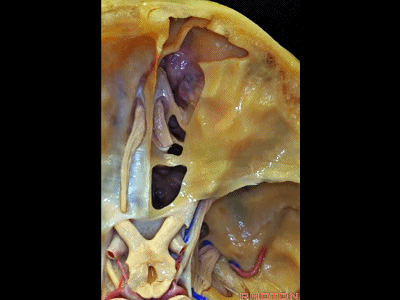
▼蝶窦(sphenoid sinus)

▼侧方是眼眶。这些区域都应该被术者暴露。
and laterally, the orbits. So that,we want to be able to deal with all of these areas.

▼从上方,我们可很好地暴露眼眶。从上方可轻易进入蝶窦,即为经颅-经蝶入路。
From above, we have great access to orbit.You can fall into the sphenoid sinus from above and do a transcranial-transsphenoidal approach.

▼也可暴露海绵窦顶壁,对于侧壁的显露不是该入路的优势。
You have access to the roof of the cavernous sinus,not very good to the lateral wall.
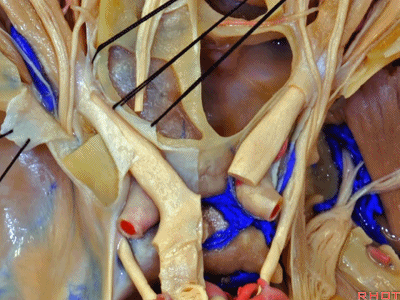
▼我们需要具备贯视上下的“透视”解剖功力,将前颅窝下方的所有这些解剖结构了然于心。
But you want to have the see-through-X-ray vision looking from above, and have a good perception of all of this anatomy below the anterior fossa.

▼现在来看看这一入路的实际操作。掀起骨膜辦
So that, coming from above you can access much of this anatomy,pericranial flap.

▼显露双侧眼眶。可见内眦韧带(Medial canthal ligament),如果切断它,在做广泛的经眶壁入路时,我们须在关颅时重新缝合该韧带,以免眼球的外移。
The orbits are freed up.Medial canthal ligament,that if you divide it, you...if you're dealing with extensive opening of the wall of the orbit,you want to re-approximate it at the end of the procedure or the globe can drift laterally.

▼这里已将内眦韧带切断
And here we've divided the medial canthal ligament,
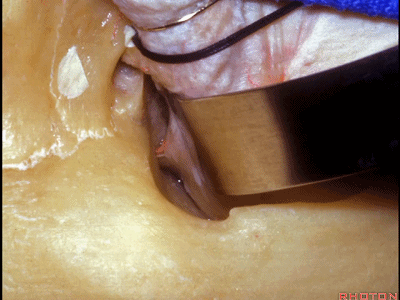
▼这是鼻泪管(nasolacrimal duct) [nə'sɒleɪkrɪml]

▼这个是穿行于眶内侧壁的筛前动脉,该动脉穿过筛板(cribriform plate)
coming through the medial wall of the orbit is the anterior ethmoidal artery. It's going to run across the cribriform plate.
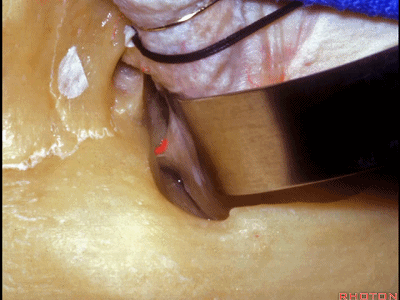
▼上述开颅可进一步扩大化,进而形成经颅-经颅底入路。
So, these openings can be very extensive and we'll turn this into a transcranial-transbasal procedure.
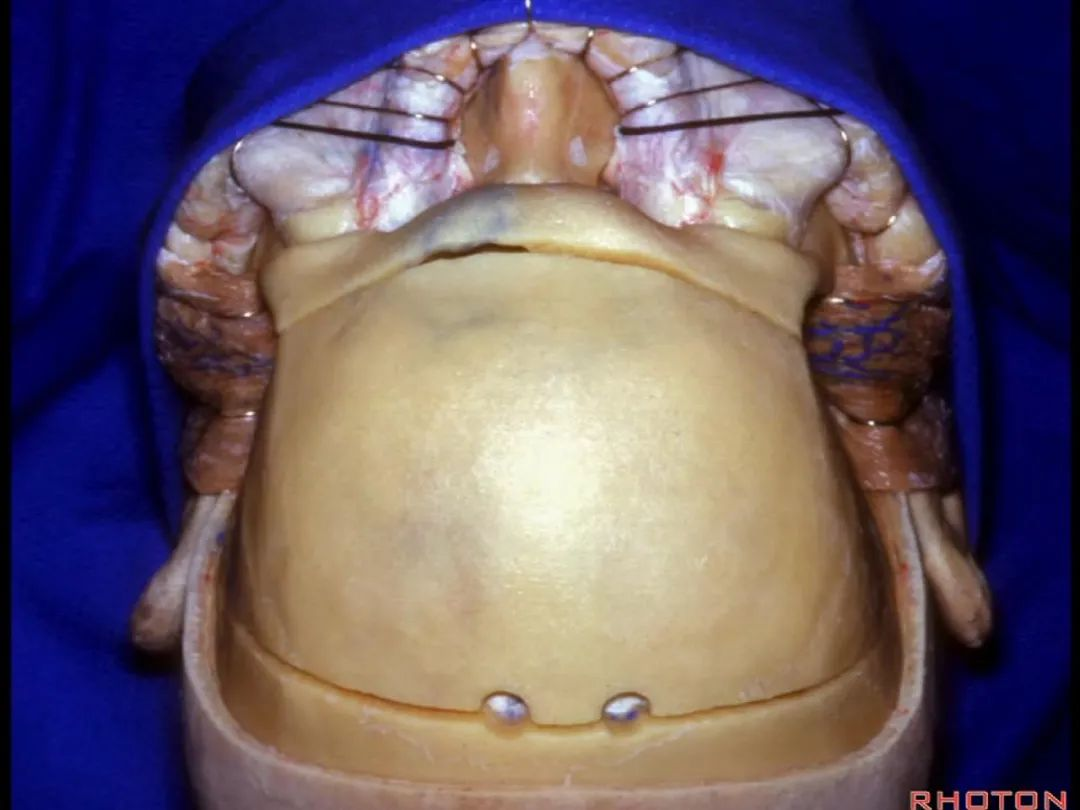

▼这是筛板处的硬膜。
the dura at the cribriform plate.

▼我们可切除筛板周围的骨质
We can do an osteotomy around the cribriform plate.

▼这里我们经额窦后方打开部分筛窦气房(ethmoid air cells)。
Here we're in back of frontal sinus into some of the ethmoid air cells.
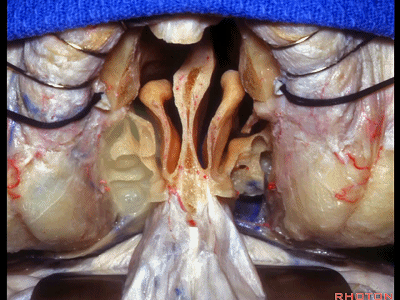
▼现在我们切除了筛板周围骨质,但这一操作常需牺牲嗅觉。这是筛前动脉(下图),该血管穿行于筛板,并进入大脑镰,可能成为镰旁脑膜瘤的供血动脉。
Here we've done the osteotomy around the cribriform plate, but that usually doesn't lead to preservation of olfaction.These are anterior ethmoidal.This artery running across the cribriform plate and eventually extending into the falx and possibly supplying falcine meningioma is an anterior ethmoidal artery.

▼我们可暴露蝶窦、鼻腔(nasal cavity)、筛窦。
We have access to the sphenoid, to the nasal cavity, to the ethmoids.


▼继续向后解剖,可进入蝶窦。走行于蝶窦下界的动脉,是由侧方的蝶腭动脉(sphenopalatine artery)发出的(下图)。它们是上颌动脉的分支,后者行经颞下窝和翼腭窝。因此,蝶腭动脉恰位于鼻腔的外侧壁。
And as we open backward, we're into sphenoid sinus. Now running along the lower margin of the sphenoid sinus are arteries that arise from laterally from what arteries? These are sphenopalatine arteries that are branches of the maxillary arteries that run through the infratemporal and pterygopalatine fossa.So these're just in the lateral wall of the nasal cavity here.

▼这一入路的外侧界,在前方是视神经。沿着蝶窦底走行的是翼管神经(Vidian nerves)
The lateral limit of the exposure anteriorly,are the optic nerves. Now, what are these? What runs along the floor of sphenoid sinus? Vidian nerves

▼翼管神经 前行至 翼腭神经节(pterygopalatine ganglion),位于鼻腔的外侧壁。我经历了上千次经蝶手术操作后才意识到,走行于蝶窦底壁的翼管神经常有骨质覆盖,但也有可能直接暴露于黏膜下,就如同该例。在内镜下,它们可作为重要标志,引导我们向后至颈内动脉岩骨段的末端。
Vidian nerves that come forward to the vidian...the ganglion here...the pterygopalatine ganglion in the fossa here in the lateral wall of the nasal cavity.I must have done a thousand transsphenoidal operations going to the sella before I realize that the vidian nerves running in the floor of sphenoid sinus often covered by bone in the floor but they may be exposed as in this case, directly under the mucosa.And in the endoscopic procedure they are great guides that lead us back to the terminal part of the petrous carotid artery.

▼现在我们打开了蝶窦。可见翼管神经引导我们至颈内动脉岩骨段的末端,后者迂曲向上移行为海绵窦段,后者是我们术野暴露范围的外侧界。
And here we've opened sphenoid sinus.Here the vidian nerves that lead us back to the terminal part of the petrous carotid that blends upward into the cavernous carotid. And these arteries are in the lateral margin of the exposure.

▼接下来我们进一步打开斜坡(clivus),即经颅-经颅底入路。
And here we've opened the clivus in this transcranial-transbasal exposure.

▼切开硬膜后,可见椎动脉(vertebral arteries)
And then we've opened the dura. We see vertebrals,

▼基底动脉(basilar artery) [ˈbæsələr]

▼小脑前下动脉(AICA)

▼外展神经(abducens nerve)[æb'dju:sənz]

▼三叉神经上颌支,行于眶底及上颌窦顶。
that runs in the floor of the orbit and in the roof of the maxillary sinus? V2 here.

▼这里让我们看看左侧眼眶下的结构,这是翼腭窝。
And here we're looking under the orbit in the lateral part of this exposure. Here's pterygopalatine fossa.
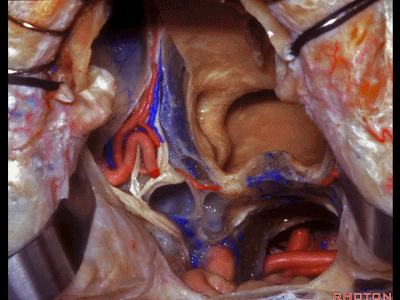
▼这是上颌窦(maxillary sinus)。因此,通过经颅-经颅底入路,上述部位都可暴露。
And this is maxillary sinus.So in transcranial-transbasal approach, you can access all of these areas.

▼同时还可以实现如下的硬膜下暴露,而不仅仅是上述的硬膜外暴露。
You have intradural access as well as extradural exposure

▼通过这一入路,我们可显露蝶鞍(sella)。
You have access to sella in the transcranial-transbasal approaches.

▼进一步打开终板(Lamina Terminalis)
Here we've opened the Lamina Terminalis,

▼可一直暴露至中脑导水管(aqueduct [ˈækwɪˌdʌkt])。
and you're looking all the way back and to the aqueduct.
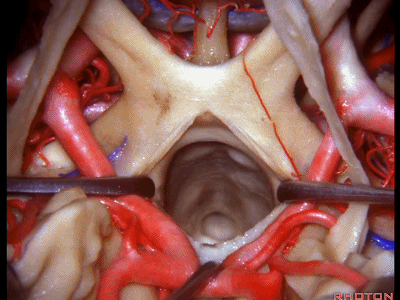
▼以上就是从上方入路对前颅底的显露。
So now, that's coming from above.
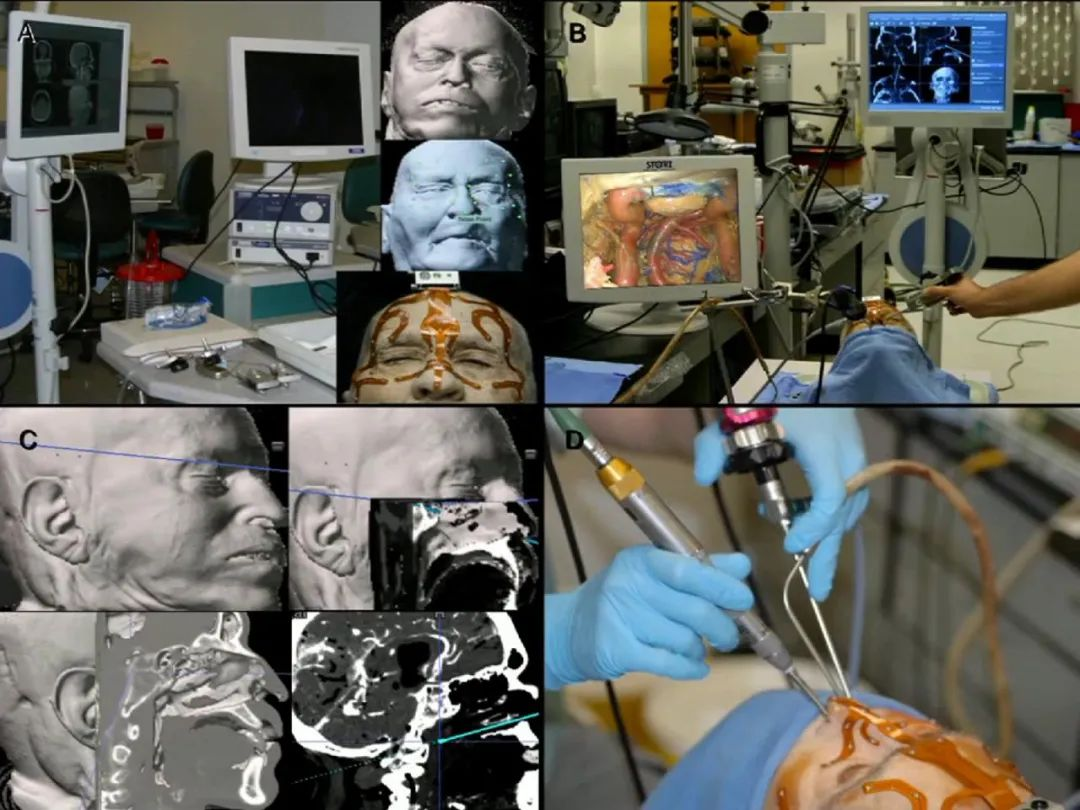
▼然而,随着现今内镜技术的发展,我们还需了解从下方经内镜暴露前颅底的入路。通过内镜,我们从下方暴露的范围从筛板(下图),
But today with the endoscopic approaches,we need to understand access from below and,using the endoscope from below we have access from cribiform plate,

▼甚至从额窦(下图),
even to the frontal sinus

▼直至下方的枢椎齿状突(odontoid [ə'dɒntɔɪd])以及寰椎(atlas)的下界,都可由经鼻入路实现。
all the way down to the odontoid and the lower margin of the C1 in these transnasal approaches.

▼因此,我们需同时掌握上方入路和下方入路。
So, you want to have the view from above, but you also want to develop that view from below upward.

▼我们来看一下颅底下方的结构,鼻腔位于中线。
And if you Look at the area below the skull base, we have nasal cavity in the midline,

▼经过鼻腔,我们暴露的范围可从筛板,其位于直回(gyrus rectus)下方,
that through the nasal cavity you have access from cribiform plate,here below gyrus rectus,

▼一直向后至蝶鞍,向下至斜坡。
all the way back to the sella,and down the clivus.

▼在侧方有上颌窦。因此,通过内镜技术,在前方,我们可利用上颌窦和鼻腔,暴露从一侧到另一侧的眶外侧壁(lateral orbit)。
But laterally you have the maxillary sinuses.And so if you look at this, think about the endoscopic possibilities from the front,using maxillary sinus and nasal cavity,you have access from lateral orbit all the way to contralateral lateral orbit.

▼这是颞肌(Temporalis Muscle)
What muscle is that?Temporalis Muscle.

▼通过上颌窦的后壁,我们可进入颞下窝 (infratemporal fossa)。
Coming through the back wall of the maxilla you have access to what fossa here? And then we go medially is infratemporal fossa.

▼进一步可显露翼腭窝。通过上颌窦的后壁,我们可进入翼腭窝,其位于鼻腔的外侧。
And then if we go into the pterygopalatine fossa, here, at the back...through the back wall of the maxillary sinus, we have access to pterygopalatine fossa in the lateral wall of the nasal cavity.

▼这里看到的是上颌动脉(infratemporal fossa),行于鼻中隔上。内镜下手术的一个重要步骤就是利用带有上颌动脉血管蒂的鼻中隔粘膜辦(septal flap)修补颅底切口。
And here we see the branches of maxillary artery coming onto the nasal septum. And,an important step forward in endoscopic surgery has been the septal flaps hinged on branches of the maxillary artery.
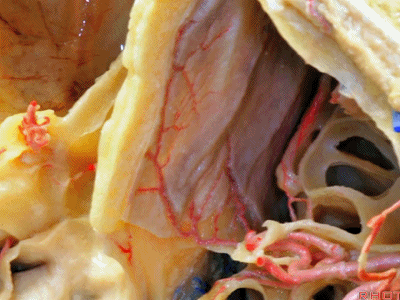
▼来看一下鼻中隔(septum)的血供来源。此处的供血动脉是筛动脉(ethmoidal arteries)
So that, above you have septum supplied by arteries here, these are branches of ethmoidal arteries.

▼下方的鼻中隔的血供来自上颌动脉,其蝶腭分支(sphenopalatine branch)供应鼻中隔下部的大部分血供。利用这些粘膜辦有用于颅底的修补。
Below, here septum supplied by maxillary, sphenopalatine branch of maxillary artery that supply most of the the lower septum.You can turn flaps and mucosal flaps that help you closing, close up the skull base.
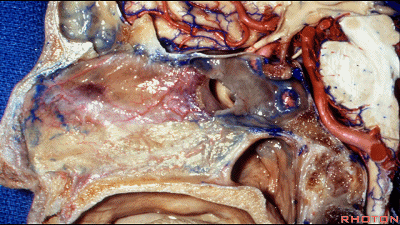
▼这些就是筛动脉(ethmoidal arteries),它们是眼动脉(ophthalmic artery)的分支,走行于视神经上方,并通过筛骨至大脑镰(falx)、筛板,并向下行于鼻腔。
So here we see the ethmoidal arteries.that are branches of the ophthalmic artery that passes above the optic nerve and then through the ethmoids to the falx, cribiform plate,and turn downward in the nose.

▼这些是上颌动脉的分支,其穿过蝶腭孔(sphenopalatine foramen)到达鼻中隔。
And here we see these branches of the maxillary artery that come through the sphenopalatine foramen to this septum.

▼这里血供极为丰富。带蒂粘膜辦可取自鼻甲(turbinate),或者鼻中隔(septum)。
these arteries are fairly rich in supply. You can hinge a flap on a turbinate, or on the wall of the septum.

▼这里看到的就是鼻中隔粘膜辦(septal flap),由上颌动脉的分支供血,可利用其修补前颅窝缺损。
Here we see a septal flap started hinged on a branch of the maxillary artery.You can fill a large hole in the anterior fossa,

▼或者向下修补斜坡。
or fold it downward into the clivus.


▼这一技术推动了内镜技术在颅底外科的应用。
So this has been one of the significant steps forwards in expanding these endoscopic approaches to the skull base.

▼接下来,我们细细看一下每块颅骨,并最终重塑出整个颅底。下图示筛骨(ethmoid bone),长有鸡冠(crista galli)以附着大脑镰(falx)。
We wanna just take a few minutes now and build a skull base.And, I was walking on the beach in Florida one day, and came on this skull.And someone said,this is a shark skull.Now what kind of shark do you think that is? What sort of shark has a skull that looks like that?Anyone wanna take a shot of that? For a cup of coffee, what is that? What do you think? Anyone live in a beach community? Well what kind of a shark has a crista galli that a falx attaches to?

▼中鼻甲(middle turbinate)亦附着于筛骨。
Has a middle turbinate attached to it?

▼筛骨眶板构成眼眶的内侧壁。
Has a plate here that faces the orbit?

▼筛骨还有内含空气的筛泡(ethmoid bulla)
And then has some air filled bulla? Is that really a shark skull? What kind of bone is that? That's a human ethmoid bone.

▼接下来继续构建我们的颅底,让我们首先从位于中央的蝶骨开始,其包括由蝶窦和蝶鞍组成的蝶骨体(下图)
So, now we'll build our skull base and we'll start at the center of the skull on the sphenoid bone, that has a body that contains the sphenoid sinus and sella,

▼蝶骨小翼(a lesser wing)

▼蝶骨大翼(a greater wing)

▼这是翼突(pterygoid process)。
And what do we call this? This is pterygoid process.
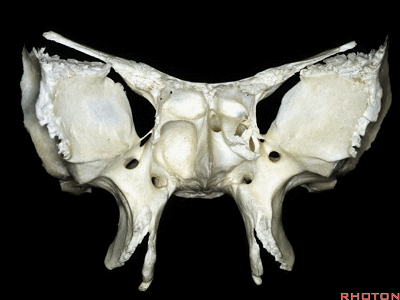
▼这区域的外侧是 颞窝(temporal fossa),内有颞肌附着。
Now, out in this area,what fossa is this? What attaches here? Temporalis muscle.So this is temporal fossa.

▼这里是颞下嵴(infratemporal crest)
And then there is a infratemporal crest.

▼颞下嵴内侧,位于蝶骨大翼下方是 颞下窝。
And medial to it below the greater wing is infratemporal fossa

▼颞下窝内侧、在翼突前方的是 翼腭窝(pterygopalatine fossa)
And then it opens medially here in front of the pterygoid process and what fossa is in this area? Is pterygopalatine.

▼眶上裂(Superior orbital fissure)

▼翼管神经(vidian nerve)行于蝶窦底,穿行于翼管(Vidian canal 下图),进入翼腭窝 至 翼腭神经节(pterygopalatine ganglion) [tərɪɡəʊ'pæleɪtaɪn]。
What foramen is this? what comes through here,in the floor of sphenoid sinus?Vidian canal for vidian nerve that enters pterygopalatine ganglion in the fossa.

▼这是圆孔(foramen rotundum [rəʊ'tʌndəm] 下图),其内走行的是进入翼腭窝的三叉神经上颌支。
And this is foramen rotundum through which 2nd division passes to enter pterygopalatine fossa.

▼因此,在这一区域,我们可见蝶窦、蝶鞍,鼻腔侧壁、翼腭窝。
So that if we look here, just at this area, we see sphenoid sinus,sella,and in the lateral wall of the nasal cavity,we have what fossa? (pterygopalatine fossa)

▼进入翼腭窝的是 翼管神经,其加入 翼腭神经节。
And entering the pterygopalatine fossa here is what nerve? Vidian nerve that enters the ganglion.

▼这里,稍外上方的是圆孔,其内穿行有三叉神经上颌支,并进入翼腭窝。
And here,a little bit superior and lateral is foramen rotundum through which 2nd division passes to enter the pterygopalatine fossa.

▼那么,连于此处的是哪块颅骨?什么位于蝶骨的前方?
So now, what bone is going to fit in this area? What backs up to the front of the sphenoid?

▼筛骨(Ethmoid bone)

▼这是筛板(cribriform plate)
that has cribriform plate,

▼眶板(orbital plate 下图),此处的筛骨纸板(lamina papyracea ['læmənə]),构成眼眶菲薄的内侧壁,可轻易地通过它进入眼眶,这常在内镜下经筛骨入路中用到。
and orbital plate,This lamina papyracea here,that thin medial wall of the orbit, it's easy to get through it and get into the orbit when you're doing some of the endoscopic procedures through the ethmoid.

▼这是筛骨垂直板(perpendicular plate [ˌpɜ:pənˈdɪkjələ(r)] 下图),其构成鼻中隔的上部。
Here we see perpendicular plate of the ethmoid that formsthe upper part of the nasal septum.

▼从上方看筛骨,这是筛板(下图)。筛窦气房开口于前颅窝吗?在筛板的外侧,额骨构成了筛窦气房的顶。
Now we're looking at ethmoids from above,cribriform plate. Do the ethmoid air cells open into the anterior fossa? What roofs the ethmoid air cells lateral to the cribiform plate? Is it actually open here under the dura? No.

▼这是下面观。额骨构成筛窦气房的顶壁,位于筛切迹(ethmoidal notch 下图)的外侧,筛切迹正是筛板的位置。
The frontal bone roofs the ethmoid air cells lateral to this ethmoidal notch where the cribriform plate sits. This is the view from below.

▼这是上面观。筛板正位于此处。
Here is the view from above. And the cribiform plate fits in this area.

▼筛窦气房顶壁由额骨筛切迹外侧的额骨构成。
And the ethmoid air cells are roofed by the frontal bone lateral to this ethmoidal notch.

▼我们继续构建颅底。我们将额骨和蝶骨拼接,再放上筛骨。
So, we'll continue building the skull base. And,we put frontal bone with sphenoid.We add in an ethmoid.

▼额骨构成眼眶上缘。上颌骨、上颌骨额突构成眶内侧缘以及眶底。鼻骨在内侧。泪骨在后方。
The frontal bone forms the upper part of the orbital rim.What bone forms the medial part of the orbital rim and fits right here? What bone? I heard lacrimal bone.Any other possibilties? What about nasal bone? what bone is this that attaches to the frontal bone here? Maxilla.The frontal process of the maxilla forms the medial part of the orbital rim as well as the lower part.The nasal bones are medial.The lacrimal bone is posteriorly.
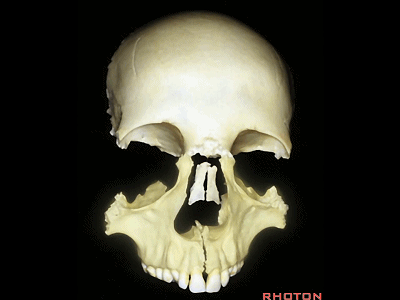
▼上颌骨
And this maxillary bone

▼上颌骨有一巨大空腔(上颌窦),经过此上颌窦 打开上颌骨。
maxillary bone has a large cavity in it,a large sinus through which if you open the maxilla,

▼向后方打开上颌窦后壁,即可进入翼腭窝(下图)。这是眶上裂(下图),圆孔在上颌骨后方开口于翼腭窝。翼管在稍内侧。
if you go directly backwards,and open the back wall, you can enter pterygopalatine fossa.And here we see superior orbital fissure and foramen rotundum opening behind the maxilla into pterygopalatine fossa.The vidian canal is a little medial.

▼打开上颌窦外侧壁,则进入颞下窝。继续向外侧,甚至可进入颞窝。也可打开上颌窦内侧壁而进入鼻腔。
If you open the lateral wall,you enter this fossa which is infratemporal fossa.And you can even open laterally and get into temporal fossa.You can also open the medial wall of the sinus and access the nasal cavity.

▼因此,我们若打开上颌窦后壁,
So that if we look at back wall of maxillary sinus and open it,

▼在上颌窦后方即可见翼腭窝(下图)
well, directly behind it we have pterygopalatine fossa,

▼三叉神经上颌支(下图)
and V2,

▼可见翼管神经末端、翼腭神经节(下图)。
the terminal end of vidian nerve, pterygopalatine ganglion.

▼打开上颌窦外侧壁,则可进入颞下窝(下图)
If we open the lateral wall of the maxillary sinus,then we have access then to infratemporal fossa

▼可见翼肌( pterygoid muscles)、翼状静脉丛(pterygoid venous plexus)、
with pterygoid muscles, pterygoid venous plexus,

▼上颌动脉分支(下图)
branches of maxillary artery,

▼以及卵圆孔(ovale [əʊ'veɪl])下方的三叉神经下颌支的各分支。
plus branches of V3 below ovale.

▼内镜下,通过经鼻入路,暴露范围可上至蝶骨平台,下至齿状突。
But endoscopically we can access from planum all the way down to the odontoid using transnasal approaches.

▼如果进一步针对鼻腔外侧壁操作,磨除三叉神经上颌支与下颌支之间的骨质
And if we work off in the lateral wall of the nasal cavity,and drill out this bone between V2 and V3,

▼我们可沿着翼管神经,向后暴露颈内动脉岩骨段,打开海绵窦前内侧壁。这些即为经鼻入路的暴露范围。
we can follow the vidian nerve backwards here on the petrous carotid. We can access anteromedial wall of cavernous sinus.So these are some of the possibilities.

▼这里(下图)是鼻腔、筛窦后壁。打开上颌窦即可显露翼腭窝。三叉神经上颌支自圆孔穿出。
Here we see nasal cavity,back wall of ethmoids.And here we are looking through the back wall of the maxillary sinus at pterygopalatine.And this is V2 at rotundum [rəʊ'tʌndəm]

▼这是翼腭神经节。
And here is the pterygopalatine ganglion.

▼观察右侧,可见翼管的前端(下图)。循着翼管神经向后,沿着蝶窦侧壁,可至颈内动脉岩骨段末端。
On one side that's the anterior end of vidian canal.And we can follow that nerve back in the lateral wall of the sphenoid sinus to the terminal petrous carotid

▼从左侧观察,这是眼眶、上颌窦外侧壁。
here we're looking from lateral,orbit,lateral wall of maxillary sinus.

▼下图示上颌窦已经打开。若打开其后壁,则可暴露三叉神经上颌支,其位于翼腭窝内。
We've opened the sinus. If you open the back wall we can access V2,in pterygopalatine fossa.

▼若向稍外侧进一步暴露则可显露三叉神经下颌支,其位于颞下窝内。
If we open it more lateral, we can access V3 and trigeminal nerve here in infratemporal fossa.

▼从左侧观察下外侧。这是蝶骨的颞下嵴。
So,here's just a view inferolateral.And here is infratemporal crest on sphenoid bone.

▼这是颞窝。颞窝与眶下裂相沟通。
what fossa is this? Temporal fossa.And you see the temporal fossa opens into inferior orbital fissure.
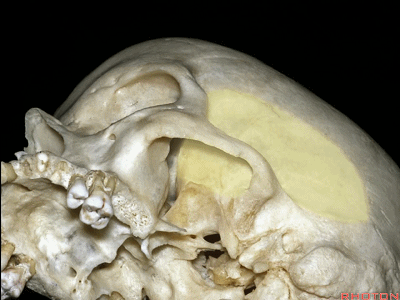
▼颞下嵴内侧为颞下窝,位于蝶骨大翼的下方。其向上与眶下裂沟通。
Then medial to the infratemporal crest is infratemporal fossa here,below the greater wing of the sphenoid.It opens above through the inferior orbital fissure.
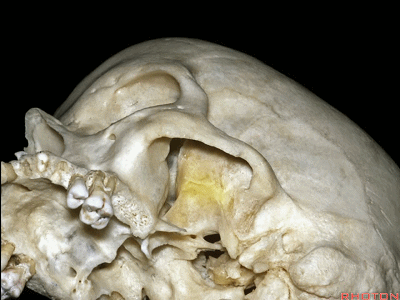
▼下图示翼腭窝,其位于上颌骨后壁与翼突之间。其向上也开口于眶下裂。
And then here is pterygopalatine fossa between the back wall of the maxilla and the pterygoid process.And it opens upward into inferior orbital fissure.

▼再从下方看右侧。可见上颌窦后壁、颞下窝,三叉神经下颌支进入颞下窝。
So this is just a view from below now.We are looking at back of maxillary sinus from below,infratemporal fossa,V3 branches entering infratemporal fossa.

▼这是翼腭窝。三叉神经上颌支出自圆孔。
Here is pterygopalatine fossa.V2 atrotundum.

▼翼管神经进入翼腭窝。
And what nerve is this? Vidian that enters pterygopalatine fossa.

▼从下方看右侧蝶鞍,翼管神经行于蝶窦底。岩浅大神经沿着颈内动脉岩骨段移行为翼管神经进入翼腭窝。
So that, if you look at the sella from below,here we have vidian nerve running along the floor of the sphenoid sinus.And,greater petrosal nerve on petrous carotid becoming vidian nerve entering pterygopalatine fossa.

▼三叉神经上颌支也进入翼腭窝。
And then 2nd division entering pterygopalatine fossa.

▼经蝶暴露至蝶窦侧壁,磨除蝶窦侧方的骨质,即在圆孔和卵圆孔之间磨除一小块骨质,即可获得前内侧视野至海绵窦内侧。
上述内容是内镜下经鼻入路的解剖学基础。
And if you're in the lateral wall of the transsphenoidal exposure,and you drill off this bone in the lateral wing of the sphenoid sinus,between rotundum and ovale,just taking that little bit of bone, gives you anteromedial access to the medial part of cavernous sinus.So this is some of the anatomic basis of the endoscopic approaches.

▼我们继续加上颧骨(zygomatic bone) [ˌzaɪgə'mætɪk]
Well we add in the zygomatic bone.

▼这是完整的眼眶骨性结构,但我们暂时不展开讨论。
We complete this orbit and I won't talk a lot about this but we need to move on.

▼这是腭骨(Palatine bone ['pælətaɪn])。这在内镜下入路中非常重要。
now what bone is this? This is an important bone in the endoscopic approaches.This is what bone?Palatine bone.
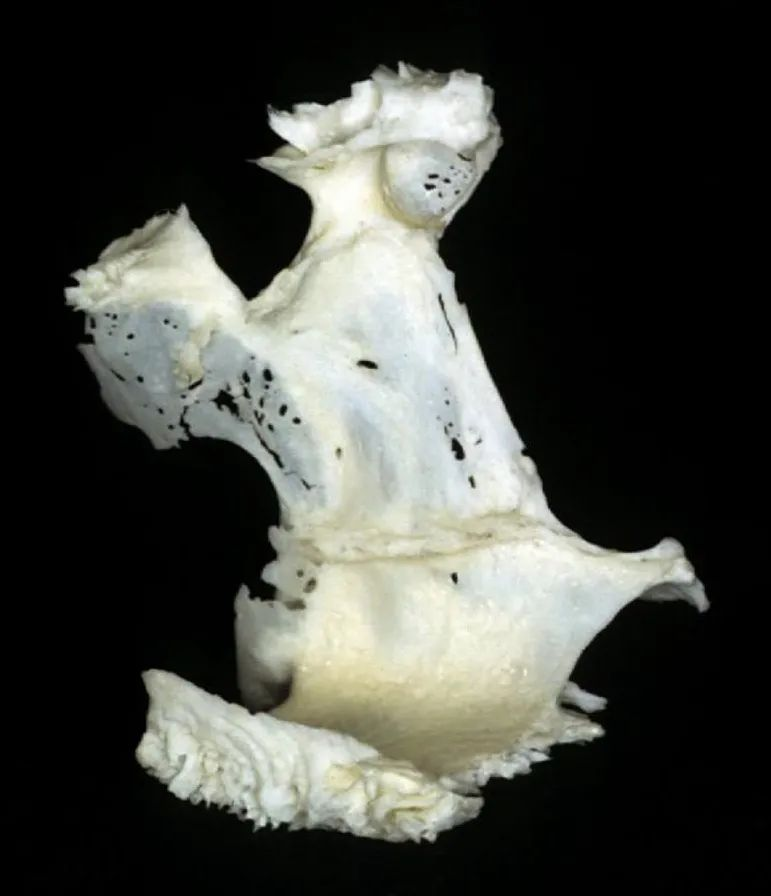
▼腭骨有一块垂直板(perpendicular plate)和一块水平板(horizontal plate)。
It has a perpendicular and a horizontal plate.

▼两块腭骨连接构成硬腭的后部。垂直板构成了翼腭窝的内侧壁。
The plates fit together,like this to complete the posterior part of the hard palate.The perpendicular part forms the medial wall of the pterygopalatine fossa.

▼中鼻甲后部附着于上方,位于蝶腭孔下方鼻腔侧壁。
下方为下鼻甲后部的附着处。
And what attaches here below the sphenopalatine foramen that is in the lateral wall of the nasal cavity? That's the attachment of the posterior part of the middle turbinate.
Here's the attachment of the posterior part of the inferior turbinate.

▼这是腭骨的眶突(orbital process),其参与构成眶底的一小部分。
And here there's a orbital process of the palatine bone that forms a small part of the floor of the orbit.
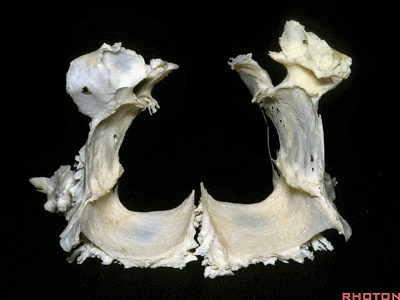
▼这是腭骨的蝶突(sphenoid process),在蝶窦下方与蝶骨下部相连。
This part, the sphenoid process joins the lower part of the sphenoid bone below the sinus.

▼这是蝶腭孔(sphenopalatine foramen 下图),上颌动脉的分支经由该孔进入鼻腔侧壁,供血于鼻甲和鼻中隔。该孔位于中鼻甲附着处后部的上方。
And here's the sphenopalatine foramen through which the branches of the maxillary artery pass in the lateral wall of the nasal cavity to supply the turbinates and the nasal septum. And that foramen is just above the posterior attachment of the middle turbinate.

▼这就是腭骨,构成翼腭窝的内侧壁。
So here we see palatine bone forming medial wall of pterygopalatine foramen.

▼这根前行的神经是三叉神经上颌支。
走行自颞下窝及翼腭窝的上颌动脉分支继续进入鼻腔并供血。
This is what nerve passing forward? V2. And coming from infratemporal and pterygopalatine fossa is a branch of the maxillary artery then it supplies the nasal cavity.

▼这些颅骨拼接起来后,这是上颌骨、构成翼腭窝内侧壁的腭骨,以及后方的蝶骨。
So the bones fit together something like this,maxilla, medial wall of pterygopalatine fossa formed by palatine bone,and then back posteriorly, sphenoid bone.

▼接下来,这块难看的骨头是下鼻甲(inferior turbinate)。独立成为一块颅骨。
Now what is this terrible looking bone? Is that a fish? That's inferior turbinate, which is its own bone.

▼现在我们从上方观察蝶骨,可见蝶骨平台(planum ['pleɪnəm]),两侧的视神经管之间的是视交叉沟(chiasmatic sulcus)。
And we look at sphenoid bone now from above,we see the planum, and then between the optic canals is the chiasmatic sulcus.

▼视交叉沟有一前缘和一后缘,视神经管位于外侧。
the chiasmatic sulcus that has an anterior limbus and a posterior limbus with the optic canals laterally.

▼鞍结节(tuberculum [tjʊ'bɜ:kjʊləm]),位于视交叉沟的后缘。实际上几乎位于蝶鞍的前壁。
And is the tuberculum on the anterior limbus or the posterior limbus of the chiasmatic sulcus? Well it's on that posterior limbus,actually down almost in the anterior wall of the sella.

▼因此,鞍结节脑膜瘤起源于此,而非蝶骨平台的后界,常位于前缘下方,沿着后缘生长。在处理鞍结节脑膜瘤蒂部时,需要从蝶骨平台周围,一直向下至蝶鞍的前壁。
So that tuberculum meningiomas arise here,not at the back edge of the planumbut actually around the corner below the anterior limbus along this posterior limbus.And if you are going to devascularize a tuberculum meningioma, well, you need to get around the corner from the planum almost down in the anterior wall of the sella.

▼这个突起是什么?这是中床突(middle clinoid)
And what is this prominence? That's a middle clinoid

▼中床突,有时可骨化,向前连于前床突。形成一个位于海绵窦顶环绕颈内动脉的骨环。
middle clinoid that can sometimes ossify over to the anterior clinoid and complete a bony ring around the carotid at the roof of the cavernous sinus.

▼侧方可见卵圆孔(foramen ovale),其位于颞下窝顶部。
Laterally we are looking at foramen ovale in the roof of the infratemporal fossa.

▼再来看鼻腔,鼻中隔上部是筛骨(ethmoid),下部为犁骨(vomer ['vəʊmə])。而前部为鼻中隔软骨(naso-septal cartilage)。
So nasal septum is formed above by ethmoid,below by vomer,and anteriorly there is naso-septal cartilage.

▼向鼻腔内部观察,这是蝶窦开口
As you look back into the nasal cavity,what foramen is this.This is sphenoid ostium.

▼这是蝶腭孔(sphenopalatine foramen),位于腭骨蝶突和眶突之间,其内有上颌动脉穿行入鼻腔。
This is sphenopalatine foramen between the sphenoid and orbital process of the palatine bone,and this is where the maxillary artery comes into the nasal cavity.

▼从侧方观察,鼻中隔上部由筛骨垂直板构成,下部为犁骨,前方为鼻中隔软骨。
So, nasal septum is formed above by perpendicular plate of ethmoid,below by vomer,anteriorly by naso-septal cartilage.

▼这是犁骨。
Here we see a vomer.

▼从上颌骨向后观察,这是犁骨、垂直板。
We look now across the maxillary bone.We see the vomer,the perpendicular plate.

▼从后方看蝶骨,这是翼管开口,位于蝶窦后界,并走行于蝶窦底。
And looking at the sphenoid bone from posteriorly,what is this opening? This is the opening for the vidian canal at the back edge of the sphenoid,and it runs along the floor of the sphenoid.

▼现在我们要加入枕骨(occipital bone),再把颞骨(temporal bone)加上去,这是颅底的上面观。
Here we...now we'll fit in...what bone fits here on the back of the sphenoid? An occipital bone.We add in the temporal bones.We see skull base here from above,

▼下面观。
from below.

▼最后,我们是否还遗漏了什么颅底的骨头?我们遗漏了三块。
锤骨(malleus ['mælɪəs])、砧骨(incus ['ɪŋkəs])、镫骨(stapes ['steɪpi:z])。
Now have we missed any bones in the skull base? We miss three. Malleus,incus,stapes.


▼以上,就是今天介绍的颅底上下面。
So we've looked at the skull base above and below.


希望对大家有所帮助。
未完待续...
推荐阅读
1
2



